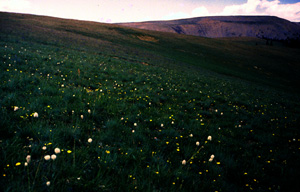Community Field Guide
Scientific Name:
Carex scirpoidea - Potentilla diversifolia Herbaceous Vegetation
Common Name:
Single spike sedge - mountain meadow cinquefoil Herbaceous Vegetation
Community Description
Summary:
This association is found sporadically in the alpine of the mountains in southwestern Montana and possibly southeastern Idaho. Elevation ranges from 2835-3150 m. This moist turf community occurs on gentle terrain that is less wind-impacted than the drier turf communities, but still accumulates little snow. Stands are found in relatively moist sites above snowbed or wet meadow communities, or on cooler northern aspects. Soils range from clay to sandy clay textures and are derived from both calcareous (limestone and conglomerate) and non-calcareous (basalt, granite, and quartzite) parent materials. Most of the sites have evidence of frost-sorting and solifluction phenomena. The dense herbaceous vegetation layer is a mixture of graminoids (66% mean cover) and forbs (47% mean cover) that is dominated by one or more of the following sedges: Carex scirpoidea, Carex heteroneura, Carex phaeocephala, and/or Carex obtusata. Other important graminoids include Carex elynoides, Carex rupestris, Festuca brachyphylla, and Calamagrostis purpurascens. Forb diversity is high with Potentilla diversifolia being most characteristic. Other forbs with high consistency and cover include Achillea millefolium, Erigeron simplex, Lloydia serotina, Phlox pulvinata, Polygonum bistortoides, Solidago multiradiata, and Zigadenus elegans. Diagnostic of this moist turf association is the dominance of Carex scirpoidea, Carex heteroneura, Carex phaeocephala, and/or Carex obtusata with Potentilla diversifolia as the characteristic forb.
Environment:
Carex scirpoidea / Potentilla diversifolia is a moist turf type found in the Beaverhead Mountain section ranges with higher precipitation (Gravelly, Snowcrest, Anaconda- Pintlar and Madison). It occurred from 9,300 to 10,320 feet associated with gentle, not nearly so wind-impacted slopes as those of the Carex elynoides community type did. Most of the sites had evidence of frost-sorting or solifluction lobes. We hypothesize these sites are turf because they occur in windswept positions (little winter snow accumulation), but they are also moist, being in runoff collecting positions or, if on slopes, ones with low solar insolation (north-facing). Carex scirpoidea / Potentilla diversifolia grades to the Carex elynoides association on upper slopes and to wet meadows or snowbed communities of yet wetter sites. With the exception of wet meadow community types, Carex scirpoidea / Potentilla diversifolia had less exposed soil and rock (4%) than any other alpine site, graminoid dominated plant association within the Beaverhead Mountain sections.
Vegetation:
Dominance of Carex scirpoidea, Carex atrata, Carex phaeocephala, Carex obtusata or a combination of these sedges is diagnostic for this community type. Graminoid canopy cover averaged 66%, of which 35% was Carex scirpoidea. Carex elynoides, Carex rupestris, Festuca ovina and Calamagrostis purpurascens were strongly represented. Elymus trachycaulus, Luzula spicata and Poa alpina had high constancy and low coverage. Average forb coverage (47%) was high, reflecting the favorable moisture status of these sites. Forbs with high constancy (> 50%) included those typical of moist sites such as Lloydia serotina, Erigeron simplex, Polygonum bistortoides, Polygonum viviparum and Zigadenus elegans. Other high-constancy forbs included Cerastium arvense, Hymenoxys grandiflora, Lupinus argenteus, Pedicularis parryi, Solidago multiradiata, and most characteristically Potentilla diversifolia. Forbs consistently present, but more typical of dry turf or cushion plant communities, included Minuartia obtusiloba, Oxytropis campestris and Phlox pulvinata.
Range:
This community is found sporadically in the alpine of the mountains within the Beaverhead Mountains Section of the Middle Rocky Mountains Province (Bailey 1995).
Global Rank: G3? State Rank: S2
Global Rank Comments:
This association is apparently most extensive in the Beaverhead Mountains Section of the Middle Rocky Mountain Steppe-Coniferous Forest-Alpine Meadow Province (Cooper et al. 1997) with outliers of the same, or a closely allied type, in the Big Snowy Mountains of central Montana; nine vegetation plots document the occurrence of this type. The Montana occurrences of this type are small (<1 acre) and confined to moist sites found in those southwestern Montana ranges (Gravelly, Snowcrest, Anaconda-Pintlar, and Madison) with greater precipitation; at least two examples are protected in two different U.S. Forest Service Research Natural Areas. Idaho and Washington have been identified as having the relatively common (S3) Carex scirpoidea var. pseudoscirpoidea Herbaceous Vegetation (CEGL001865), but there are no literature citations to substantiate the Idaho occurrences. The Carex scirpoidea community of Washington North Cascade Range is floristically dissimilar this association, and it occurs in a very different position with respect to local moisture gradients. None of the several pertinent alpine vegetation studies conducted in the adjacent Bitterroot Mountains or Challis Volcanics Sections of Idaho have identified a Carex scirpoidea-dominated association, though Carex scirpoidea occurs within the alpine flora of that region. Minor threats to this association are posed by mining and associated roads and domestic sheep grazing. With their preference for forbs, sheep can significantly shift stand composition further toward graminoid dominance.
Community References
Identifier:
CEGL001867
Author:
97/10 / S. V. Cooper et al.
Citations:
Bamberg and Major 1968, Bourgeron and Engelking 1994, Cooper and Lesica 1992, Cooper et al. 1997, Cooper et al. 1999, Douglas and Bliss 1977, Driscoll et al. 1984
View Detailed Citation Information | New Community Search | NatureServe Explorer Community Information
This information is from the:
Montana Natural Heritage Program
Montana State Library--Natural Resource Information System
1515 East Sixth Ave., Helena, MT 59620-1800
406 444-3989
mtnhp.org
mtnhp@mt.gov






